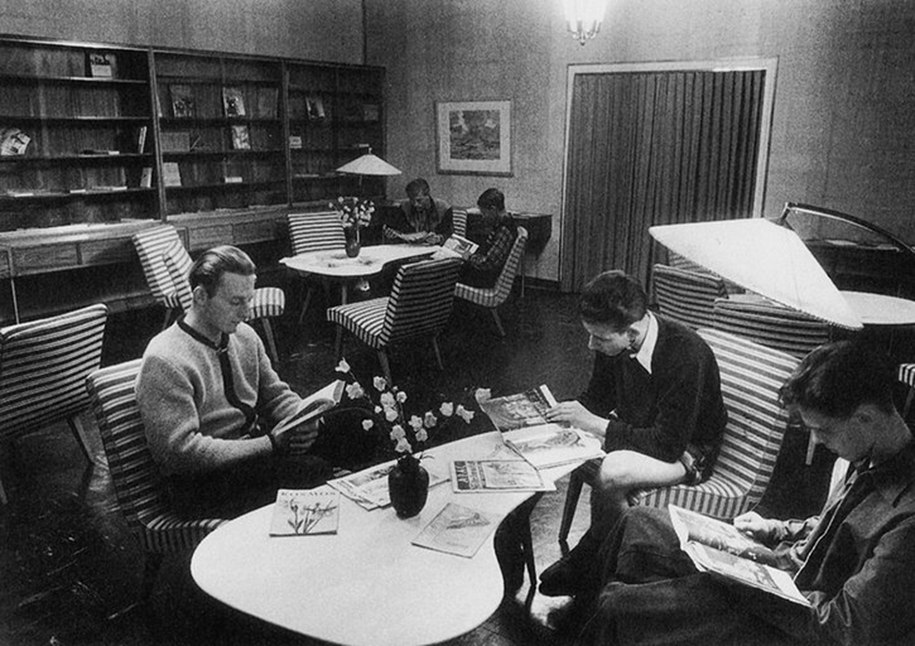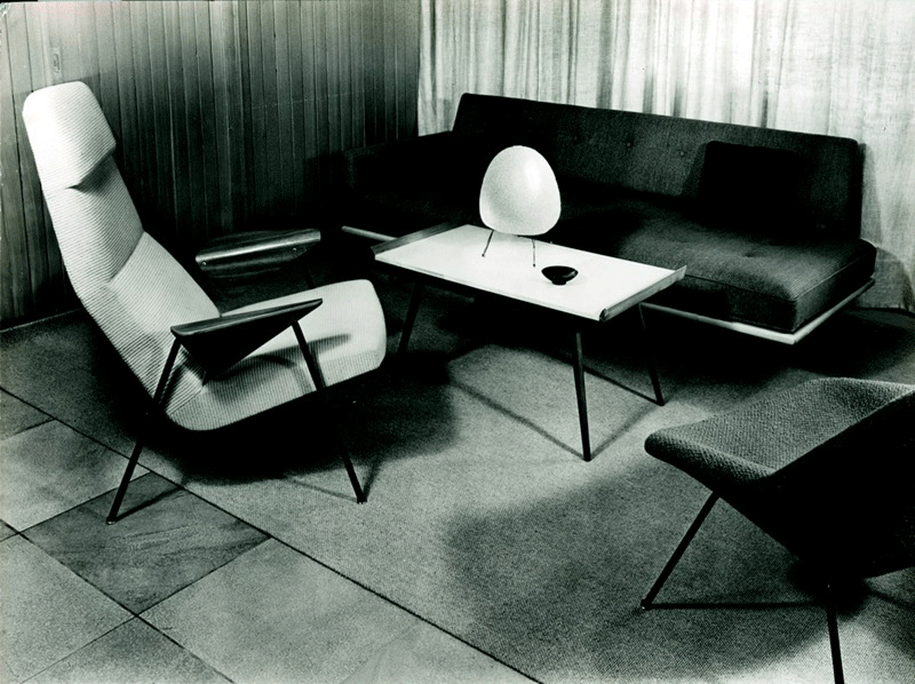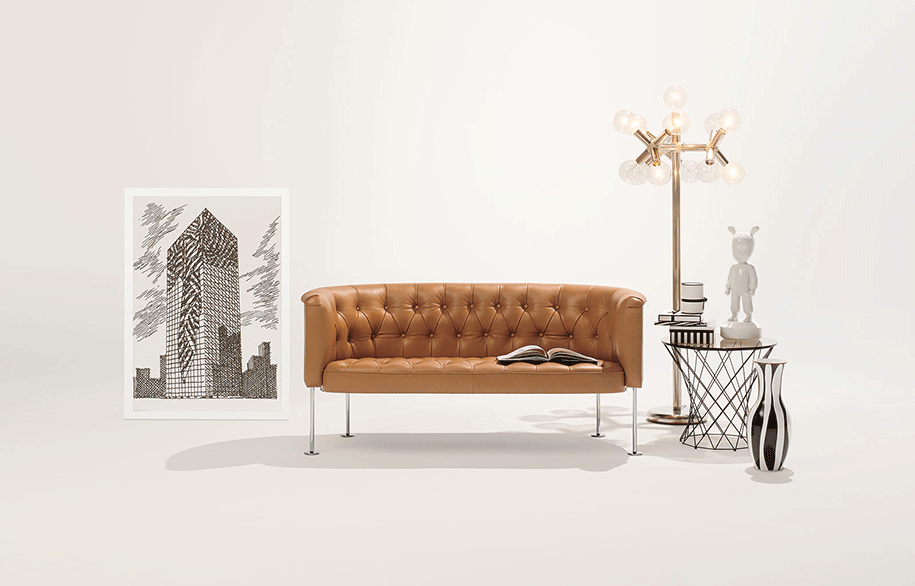.

Wilhelm Knoll
1865
Wilhelm Knoll, the founder of the Knoll dynasty, opens the doors of his “leather shop” in Stuttgart, Germany. Widely travelled expert in leather: in 1864, annual stay in Paris – the world centre of leather, fashion and luxury goods.
“Knoll leather” becomes the hallmark of quality, and the House of Württemberg names Wilhelm Knoll, “Supplier to the Royal Court.”
1866
TV is invented. The first transatlantic cable is put into operation. Here, the world began to look at the idea of fusing technology with design, where televisions became almost like sculptural pieces in the home – assuming of course, that you were lucky enough to have one…
1906
The leather furnishings factory (Ledermöbelfabrik) becomes the leather seating factory (Ledersitzmöbelfabrik Wilhelm Knoll).
 1906 – Peter Behrens is responsible for the architecture and corporate identity of AEG.
1906 – Peter Behrens is responsible for the architecture and corporate identity of AEG.
Left: Willy Knoll (1878 – 1954). Right: Walter Knoll (1876 – 1971).
1907
In 1907, Wilhelm’s sons Willy and Walter take over their father’s business and start producing seating, beginning the Knoll family design dynasty. This year under Willy and Walter, the company introduces the first ‘club armchair‘ to Germany. It was a revolution in the fashion of luxury furniture at the time, pushing the boundaries of traditional aesthetics and materials.

1907 – Wilhelm’s sons Willy and Walter introduce the first club armchair to Germany.

1919 – Walter Gropius founds the Bauhaus in Weimar.
1919
The hugely-significant Bauhaus Movement is born. Walter Gropius founds the Bauhaus in Weimar.

1920s – “The psychology of seating”: the lightweight Prodomo armchairs perfectly reflect the spirit of the times of the twenties.
1925 – 1929
Advocating modernity and leveraging of Germany’s growing influence in design around the world, the urbane gentleman Walter Knoll, founds his own company at the age of 50: Walter Knoll & Co. GmbH.

1925-1929 – The “Prodomo“ models developed by Walter Knoll are seen as the first modern upholstered furniture in history.

1927 – The exhibition “Die Wohnung“ (The Apartment) under the direction of Mies van der Rohe (pictured) at the Weissenhof Estate in Stuttgart sets standards for modern building and living all over the world.
1938
Being equipped with the knowledge of the Bauhaus movement and the abilities of his family, Walter Knoll´s son, , goes to the U.S. in 1938 – originally to sell the products of his father. However, fate intervenes where he meets the architects of modernity and opens his own business in 1939.

1938 – Stuttgart – centre of the avant-garde: Oskar Schlemmer and his “Triadic Ballet“.
1939
The start of the Second World War.
The German design economy has to take second place to the war effort, and as a result, the expansion at Walter and Wilhelm Knoll comes to a standstill. Production has to concentrate on manufacturing articles important for the war.
1942
As the WWII escalates, serious bomb damage causes the Walter Knoll production to be closed.
1945
End of the war. The company faces a new start.
1946
Robert Knoll becomes a partner at Walter Knoll.
1947
While Germany is still accustomed to more traditional furnishings after 1945, Walter Knoll is presenting a modern way of life to shape the future of Germany’s design economy after the war. Hans Knoll supports his father in this time of reconstruction with the “Vostra“ model.
1948
IBM makes the first mainframe computer. This of course has huge implications on the design world. Traditional handmade craftsmanship is challenged by digital technology.

The bucket seat 369 at the Hilton Hotel in Berlin – still one of today‘s modern classics.
1949
Founding of the Federal Republic of Germany (FRG) and the German Democratic Republic (GDR). Konrad Adenauer becomes Chancellor.
During this exciting polictical period in Germany, the upholstered version of the Vostra armchair perfectly reflects people’s attitudes in this time of awakening, and propels Walter Knoll to regain international recognition.

1950
The Furniture Fair in Cologne is the breakthrough for furniture by Wilhelm Knoll. Dieter Knoll takes over the running of the company Wilhelm Knoll after the death of his father, Willy.

1953 – Student hall of residence in Hamburg, with Vostra armchairs.
1953
The establishing of the now famed HFG College of Design in Ulm and the national Foundation of the Design Council (Rat für Formgebung).

1956 – The Walter Knoll Votteler Chair
1957
Bundesrat (Upper House of Parliament) passes a bill on the equality of men and women. The impact of this political movement revolutionised design, widening the boundaries of what design and architecture could (and should) be.

1957 – Walter Knoll 357 Chair

1962 – Walter Knoll Haussmann Lounge
1964
Walter Knoll retires. The company is handed over to Robert Knoll and Dr. Walter Combe.

1968
Frei Otto designs the tent-like roof construction for the Olympic Stadium in Munich. This is treated as an opportunity to further establish and showcase Germany’s design culture, the centrepiece of which is the Olympic Stadium in Munich.

1969
The Moon landing; Neil Armstrong (USA) is the first man on the moon. This sends an inspiring message to rest of the world.

1975 – The furnishing of Berlin‘s Tegel Airport. The Berlin Chair is created for the airport‘s VIP lounge.
1970
The Contract division of Walter Knoll is established in the seventies. Elegant executive offices, comfortable swivel chairs, fine conference facilities, as well as elegant sofas for foyers and lobbies account for the success in furnishing business premises. Walter Knoll were pioneers in establishing design’s role in the workplace.

Berlin‘s Tegel Airport in 1975

1975 – Walter Knoll Berlin Chair

1972 – Walter Knoll Fabricius Chair
1975
The furnishing of Berlin‘s Tegel Airport is without doubt one of the highlights of the company‘s history. Together with architect Meinhard von Gerkan, the Berlin Chair is crafted exclusively for the airport‘s VIP lounge.
1982
Stephan Combe and Michael Knoll become Managing Director of Walter Knoll.
1983
The first commercial mobile phone is launched onto the market (Motorola), changing the way we do business and interact socially forever.
1985
Walter Knoll takes over the company Wilhelm Knoll and continues to sell the products as the “Wilhelm Knoll Collection”.
1993
The famous furnishing family Benz buys the Walter Knoll company. Markus Benz, the oldest son, has been running the business ever since with the experience of excellent upholstery craftsmanship and modern corporate culture. A significant moment for the brand.
1990
German reunification means a negotiated 35-hour week is introduced in Baden-Württemberg, changing the German economy – where all business’, including Walter Knoll, were challenged to re-adapt and grow.
1993
Founding of the European Union (EU). The better connected Germany and by extension Walter Knoll, with their wider European neighbours, which had great influence on the brands output.
2003
The last Volkswagen Beetle is manufactured in Puebla/Mexico, and is seen as the loss of one of Germany’s greatest design legacies.
2007
Walter Knoll Australia born, and Walter Knoll receives the Design Management Europe Award for their successful design management.

2007
Apple introduces the first generation of the iPhone. And everything changes rapidly. The way people consumed design shifted tremendously, and Walter Knoll adapted their brand accordingly without compromising the philosophy of the brand.
2008
The crash of the American bank Lehman Brothers marks the beginning of the global financial and economic crisis. Design, particularly luxury design, takes a big hit. But Walter Knoll perseveres, reassessing what is most important to them.

2012 – Walter Knoll Mötzingen
2012
Inauguration of the new multifunctional building for assembly, production and logistics in Mötzingen.
2013
Famed multidisciplinary identity architects, the Ippolito Fleitz Group, join forces with Walter Knoll to evolve the physical experiences created by the brand in the Walter Knoll showrooms, display areas of their partnering distributors and global design event stands.

2014 – Walter Knoll interactive “The office in the jungle?” stand at Orgatec, Germany by the Ippolito Fleitz Group.
2015
Walter Knoll celebrates 150th anniversary!


Want to know more about what it takes for design to survive 150 years? Head to Walter Knoll Australia, available nationally.

